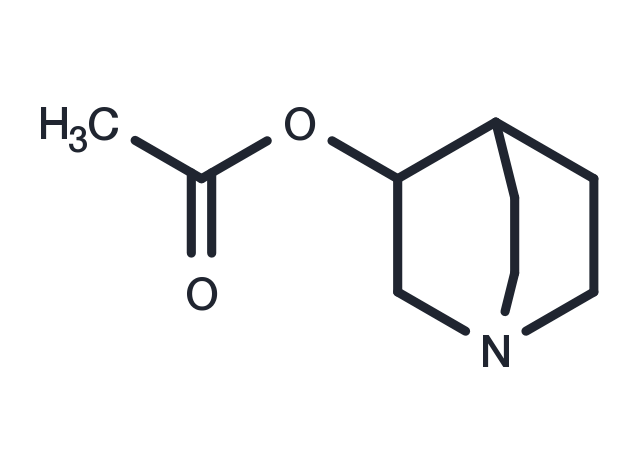Powder: -20°C for 3 years | In solvent: -80°C for 1 year
Aceclidine (1-azabicyclo[2.2.2]octan-3-yl acetate) is a modulator of M3 mAChR and can be used in studies about treating glaucoma by reducing intraocular pressure.

| パッケージサイズ | 在庫状況 | 単価(税別) | |||
|---|---|---|---|---|---|
| サンプルについてお問い合わせ | |||||
| 50 mg | 在庫あり | ¥ 13,500 | |||
| 100 mg | 在庫あり | ¥ 19,000 | |||
| 200 mg | 在庫あり | ¥ 28,000 | |||
| 500 mg | 在庫あり | ¥ 45,500 | |||
| 説明 | Aceclidine (1-azabicyclo[2.2.2]octan-3-yl acetate) is a modulator of M3 mAChR and can be used in studies about treating glaucoma by reducing intraocular pressure. |
| 別名 | 3-Acetoxyquinuclidine, 1-azabicyclo[2.2.2]octan-3-yl acetate, NSC657843, 3-quinuclidinyl acetate, NSC-657843, Glaucostat, NSC 657843, Quinuclidin-3-yl acetate |
| 分子量 | 169.22 |
| 分子式 | C9H15NO2 |
| CAS No. | 827-61-2 |
Powder: -20°C for 3 years | In solvent: -80°C for 1 year
H2O: 10 mg/mL (59.1 mM), Sonication is recommended.
DMSO: Soluble
You can also refer to dose conversion for different animals. 詳細
bottom
Please see Inhibitor Handling Instructions for more frequently ask questions. Topics include: how to prepare stock solutions, how to store products, and cautions on cell-based assays & animal experiments, etc.
Aceclidine 827-61-2 Neuroscience AChR 3-Acetoxyquinuclidine 1-azabicyclo[2.2.2]octan-3-yl acetate Quinuclidin-3-yl Acetate NSC657843 3-quinuclidinyl acetate NSC-657843 Glaucostat 1-azabicyclo[2.2.2]octan-3-yl Acetate 3-quinuclidinyl Acetate NSC 657843 Quinuclidin-3-yl acetate Inhibitor inhibitor inhibit
